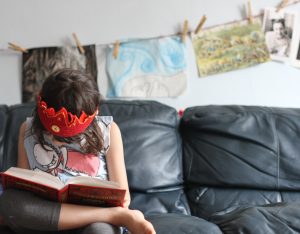By Amy Fredland, former Oak Meadow k-4 teacher
PART I:
During my years working with OM, I heard many families express great concern about how to start and how to fit homeschooling into “life.” This particularly comes at the beginning of the school year, as there are so many variables to consider, plan and prepare for, and mull over. Some find this inspiring, while for others this can be intimidating. I hope you and your child will consider the beginning of the school year truly as a period of transition. Keeping in mind that transitions are not static points in time but dynamic processes, I encourage you to consider that many times the first few months of the school year end up focusing on getting into and/or remembering habits and strategies for school related tasks. This can be true for returning homeschoolers, as well as those completely new to homeschooling.
 In order to support this transition I often recommend that you take time at the beginning of the school year to map out the activities and tasks you need to do each week, both for your home and for your school. In this way you are crafting a rhythm for your days and your weeks. Although this doesn’t need to be followed exactly each moment, it is a wonderfully supportive framework into which you can immerse yourself and your children. It allows you NOT to have to “recreate the wheel” each day. Phew! Much time and energy is saved this way! This is particularly helpful when things get hectic or stressful, and you find that your creative energy is being directed towards other pressing needs. When this time comes around, you’ll find your weekly rhythm is there waiting for you, and you can simply allow it to guide you and your child through the day.
In order to support this transition I often recommend that you take time at the beginning of the school year to map out the activities and tasks you need to do each week, both for your home and for your school. In this way you are crafting a rhythm for your days and your weeks. Although this doesn’t need to be followed exactly each moment, it is a wonderfully supportive framework into which you can immerse yourself and your children. It allows you NOT to have to “recreate the wheel” each day. Phew! Much time and energy is saved this way! This is particularly helpful when things get hectic or stressful, and you find that your creative energy is being directed towards other pressing needs. When this time comes around, you’ll find your weekly rhythm is there waiting for you, and you can simply allow it to guide you and your child through the day.
You can begin to create your weekly/daily rhythm by first identifying important aspects of your days. You might choose to make lists, a sketch or brainstorming map, or a spreadsheet. You can really utilize any method of organization that helps you become clear about the things that are necessary for you and your child to meet the goals you have in mind for the school year.
Examples of things you may want to include for your school activities:
Language Arts
Math
Circle Time
Art/handwork
Field Trips
Sports/social activities
Reading time
Baking
Social Studies
Science
Snack/meal times
Music
Nature walks
Rest/quiet time
Free play time
Woodworking, etc.
In addition, it can be helpful to include regular household tasks/activities that need tending each week. You may or may not include these on the actual schedule your children see each day, but it can be very helpful to give these activities a specific place in the overall family rhythm. You might find it useful to make a small schedule for yourself to refer to throughout the week that includes both these activities and the ones listed above.
These household activities may include:
Meal preparation/clean up
Laundry
Grocery shopping
Tidying up (dusting, mopping, vacuuming, etc.)
Specific chores
Errands
Parent work times
Once you have identified the areas that are important in your week, you may want to include your children in this conversation. What do they want to make sure there is time for each week or each day? You may be surprised to hear they really want to have time for baking each week, or that it’s important they have time for playing outside each morning before school begins or right after your first lesson of the day.
PART II:
 Now, here comes the fun part! There are many ways to create a physical representation of your weekly rhythm. For the youngest children (kindergarten and grade 1), it’s wonderful to make a picture-based chart that they can refer to each day. When I was teaching in the classroom, I made pictures for each subject/activity (e.g., a book for reading time, numbers for math time, a jump rope for outdoor time) which I drew upon large circles that I then covered with contact paper. I kept all the circles in a folder, and each day I’d help the children arrange them in the correct sequence for that particular day (based on the schedule I had written down in my planning book.) We hung them on a clothesline using clothes pins, but there are numerous other ways to display yours. My students LOVED putting up this morning schedule; it was one of the most sought after chores of the day. Not only did it give them practice with sequencing and tracking, but it allowed them to gain connection with the rhythm of the day and of each week, thereby supporting their growing awareness of time.
Now, here comes the fun part! There are many ways to create a physical representation of your weekly rhythm. For the youngest children (kindergarten and grade 1), it’s wonderful to make a picture-based chart that they can refer to each day. When I was teaching in the classroom, I made pictures for each subject/activity (e.g., a book for reading time, numbers for math time, a jump rope for outdoor time) which I drew upon large circles that I then covered with contact paper. I kept all the circles in a folder, and each day I’d help the children arrange them in the correct sequence for that particular day (based on the schedule I had written down in my planning book.) We hung them on a clothesline using clothes pins, but there are numerous other ways to display yours. My students LOVED putting up this morning schedule; it was one of the most sought after chores of the day. Not only did it give them practice with sequencing and tracking, but it allowed them to gain connection with the rhythm of the day and of each week, thereby supporting their growing awareness of time.
For older children, you may decide to have them paint or color a piece of poster board upon which they could help you write out a weekly schedule. This would then be displayed in an area of your home that allows it to be viewed and referred to easily throughout the day. If you have a chalkboard in your home, maybe you could write the schedule there. As the children learn cursive, they could be invited to do the writing on the board themselves.
Including the children in this process will allow them to begin taking more responsibility for the course of their days, and this goes very far in helping them know what is coming next. For many children this “knowing” allows them to relax into the activity at hand, thus offering them the chance to explore their learning deeply.
When crafting your weekly and daily rhythms, here are a few things to keep in mind:
Children tend to feel supported when their activities alternate between things that require them to bring very focused intention and attention to a task, and those that are more relaxed. Some describe this as a rhythm of “breathing in” and then “breathing out.” Placing an art activity or time spent outside between a math lesson and a reading lesson is an example of a rhythm that allows a student to “breathe out” between the more intellectual/cognitive experiences (math and reading.)
Activities that require concentration are not the same for all children. For instance, for some children learning to knit is not relaxing at all and can require an immense amount of concentration and focus. For this student, knitting might be an experience of “breathing in” and might need to be supported by following the knitting session with something that allows the student to literally and figuratively exhale. Perhaps reading or listening to a story would offer this chance.
The art of education has much to do with how we can meet our children each day both with the fruits of our preparation AND with a flexibility to let go of our plans and do what seems necessary to meet our children in each moment. Although children thrive when surrounded by a predictable rhythm to their days, there are times when all your senses tell you that what your child needs is something other than what you have planned. In these moments, I encourage you to listen to that instinct and let the freedom of homeschooling support you and your child as you find out, together, what your day needs to look like.
Remember: Each child is different! I encourage you to spend time observing your child and how each activity is received. Over time you will become much more in tune with what allows the out-breath, and what offers the chance to breath in. (Both are necessary, right!?) Using this information you can further craft your homeschooling rhythm; in doing so you are creating something quite unique for your child.